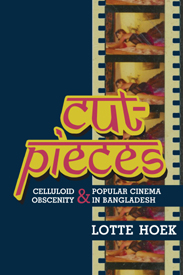How to enjoy porn in Bangladesh
by Divya KhanIn a country where heterosexual hand-holding in public is considered distasteful, Lotte Hoek explores an underground culture of ‘cut-piece’ cinema, in which short, pornographic scenes are spliced into a film and shown to audiences behind the back of the draconian censor board. Her book, Cut-Pieces: Celluloid Obscenity and Popular Cinema in Bangladesh is an ethnography of a particular film called Mintu the Murderer, from its production to its reception in Bangladesh.
Released to the public on Eid, the most religious day in the Muslim calendar, the film sparked outrage in the mainstream media as small-town audiences used their day off work not to venerate the almighty Allah, but instead to stare for precious seconds at the holiest of holies.
In the film, discrete pieces of soft porn are heralded with lines within the script. A script ending with a line such as ‘…tonight we will celebrate…’ will usher in – and be an excuse for – a completely unrelated piece of pornography. Experienced audiences know when to expect these sequences and cheer them in.
Hoek takes us through each part of her experience with the film: from its conception, to scripts and casting, to its glorious reception in a cinema hall in the small town of Feni. At all tiers of society, the film is accepted at some level. Working class audiences cheer when the cut-pieces are aired. Of course they would, they’re a smutty lot. But Hoek shares a revealing anecdote – whilst waiting for the film to start, she spots two policemen in the cinema. She suspects that the projectionist is waiting for them to leave; in turn they ask if the white lady could please be ushered out so the film can start?
The first time she saw three entire minutes of close-ups of cunnilingus flashed onto the screen, Hoek witnessed the cinema hall burst into cheers and applause. Cheering and jeering the projectionist are part of the experience of watching films in Bangladesh. At the same time, some of the audience give vent to scandalised middle-class tut-tutting as if to publicly exonerate themselves while others seem to stare guiltily at the floor when the cut-pieces are aired.
The cut-piece film creates a space where these social double standards are freely expressed. Even Raju, the manager of the sordid cinema hall in Feni describes the cut-piece film as ‘vulgar’, despite conceding that they are what the audience wants most. He says “Films wont run without cut-pieces… only with vulgar films containing cut-pieces do you get a repeat audience. That’s where the money is made.”
Six weeks after the film was released, Mintu the Murderer was banned after the censor boards discovered these cut-pieces. And here we get an insight into the film’s life outside the cinema. Cut-pieces are not standardized pieces of mass-produced porn, each version of the film has a different selection of these scenes, with due sensitivity to the audience’s needs. Hoek describes that editors and producers made various versions of the film for different audiences: for instance, some discs of the film have hardcore scenes of bondage. The cut piece is a space for creativity and fantasy, with no rules. Different versions of the film keep repeat audiences at the edge of their seats, waiting for a new piece of porn each time. Rather than searching for the ‘original’, Hoek treats these various forms of the film as responding to a different set of needs from each audience.
 Hoek’s evaluation of the various circumstances she encounters is engrossing. In a way that is rare for such a thoroughly academic project, she keeps the book alive by deftly interspersing the more serious text with funny anecdotes. Such a careful, yet lively, analysis of cinematic culture in Bangladesh deserves high praise indeed.
Hoek’s evaluation of the various circumstances she encounters is engrossing. In a way that is rare for such a thoroughly academic project, she keeps the book alive by deftly interspersing the more serious text with funny anecdotes. Such a careful, yet lively, analysis of cinematic culture in Bangladesh deserves high praise indeed.
Cut-Pieces: Celluloid Obscenity and Popular Cinema in Bangladesh, Lotte Hoek, Columbia University Press, paperback, 272 pages, illustrated, ISBN: 978-0-231-16289-0, £19.00
Featured image by Lotte Hoek

